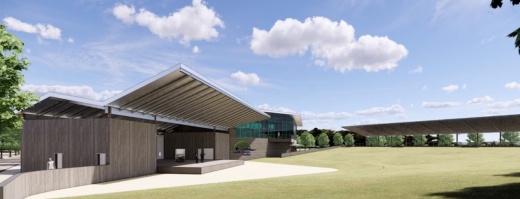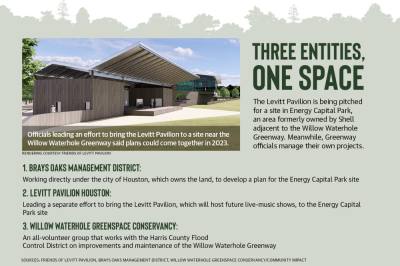In addition to the trails, plans are coming together for Energy Capital Park, a project planned for a nearly 29-acre site adjacent to the greenway that could also feature a 5,000-seat outdoor live music venue called Levitt Pavilion.
Howard Sacks, president of the nonprofit Levitt Pavilion Houston, said his group is working with the city of Houston—which owns the land—to finalize plans for the pavilion and park, an agreement for which could be reached by the end of the third quarter of 2023. The nonprofit formed in 2013 with the goal of building the Levitt Pavilion, and managing and operating it once complete.
“We’re excited to be close to an agreement regarding the site and its use,” Sacks said.
The 291-acre Willow Waterhole Greenway was built by the Harris County Flood Control District in 2004 as a site that is both a park and flood-control facility. The waterhole’s six lakes also serve as detention ponds that can hold up to 600 million gallons of stormwater, according to the Willow Waterhole Greenspace Conservancy, the all-volunteer organization that has tasked itself with improving and maintaining the greenway.
The various projects taking place in and around the greenway point toward a bright future for the site, said Bill Burhans, the conservancy’s conservation chair. People who are investing in the site recognize its distinct offerings, he said.
“This place looks different than anywhere else in Houston,” Burhans said.
Trail work moves forward
Harris County Commissioners Court approved a $2.7 million contract with MB Western Industrial Contracting Company at a Jan. 31 meeting for trail construction around the Willow Waterhole’s Westbury Lake.
Plans call for the flood control district to build 3.5 miles of trail, including a trail around the top of the bank that will be made with crushed granite and a trail around an intermediary part of the lake that would be made with concrete, Burhans said. Construction, which began in mid-February, is expected to be finished by the end of March, he said.
The conservancy also celebrated the completion of a new $260,000 fishing pier in January, a project Burhans said had been underway in planning and design since 2017. The pier was funded entirely with private donations to the conservancy.
Burhans said the conservancy has also secured funding to build trails around five of the greenway’s other lakes, including Scout, Triangle, Heron, Prairie and Willow lakes. The roughly 8 miles of new trails will be funded with $10 million in donations, including $4 million from the Kinder Foundation. Work will start in mid-2023 and run through 2024.
“Willow Waterhole is truly a diamond in the rough that is poised to transform the quality of life of Houstonians in the southwest area of the city,” Kinder Foundation President Nancy Kinder said in a statement. “It is time for Willow Waterhole Greenway to assume its rightful place as one of Houston’s great green spaces.”
Other donors include the Wortham, Fondren, Cullen and Brown foundations. The list of high-profile philanthropists backing the waterhole is evidence of its potential, Burhans said.
He said people donate to the Waterhole because they want to support projects that mix flood control and recreational elements, they are impressed by the work already done by volunteers, and they want to bring a valuable amenity to southwest Houston.
“All these other places have big parks, and they feel like southwest Houston has kind of been overlooked,” he said.
Energy Capital Park
Nearby, Energy Capital Park is being planned at a site that once served as a Shell Oil research and development facility in the 1950s and was purchased by the city of Houston in 2019. The city is partnering with the Brays Oaks Management District on determining what the site could feature.
Combining community, family fun and an opportunity for Houstonians to come together not within the Loop 610 or in the traditional spaces in the city was something District K Council Member Martha Castex-Tatum said she emphasized with the planning goals. Multiple open houses were held starting in April 2022 to get resident feedback.
“They wanted the [Levitt] Pavilion there, and I think that not only will it expand the opportunities for recreation and entertainment at the location, but I think it brings a level of professional music scene to the area,” Castex-Tatum said.
Sacks said the proposed location of the pavilion within Energy Capital Park benefits from the larger music education scene that exists within the surrounding areas, as well as the live music festivals that have taken place at the greenway since 2013.
“What connects better with our community than live music within a beautiful green space?” Sacks said. “So how can we do that more impactfully? That’s the vision for Levitt Pavilion.”
Today, while local residents and those visiting the greenway might notice metal fencing surrounding the roughly 29-acre site, the vision for its future remains open and flexible, Sacks said. The three key elements of the site—the Willow Waterhole Greenway, the Levitt Pavilion and the Energy Capital Park—each have their separate and unique campaigns that will determine how they will be brought to life, Sacks said.
Many of the details for what could come to Energy Capital Park are still to be determined, Castex-Tatum said, though she said there was already a lot of excitement about the project.
“We’re still working on the plans and what’s going to be in the actual facility,” Castex-Tatum said.
Similarly, though Levitt Pavilion is still in the early stages, Sacks said his group is already fielding interest from individuals and groups looking to support the project. Once officials reach an agreement on the site, final design work and fundraising will move forward. Levitt Pavilion, with its separate board, is likely to move forward first, Sacks said.
For Braeburn resident Barbara Richards, helping to control flooding in the area and educating the public about the park while development continues is important.
“I think it’s critical for it to be developed for flood detention,” Richards said.
Richards said she makes it a priority to walk twice a week at the green space with her friends and looks forward to the future plans for the site.
“I’m so happy that we’ve got this unique area in our midst, and I just see that there is much more potential that is coming,” she said.








